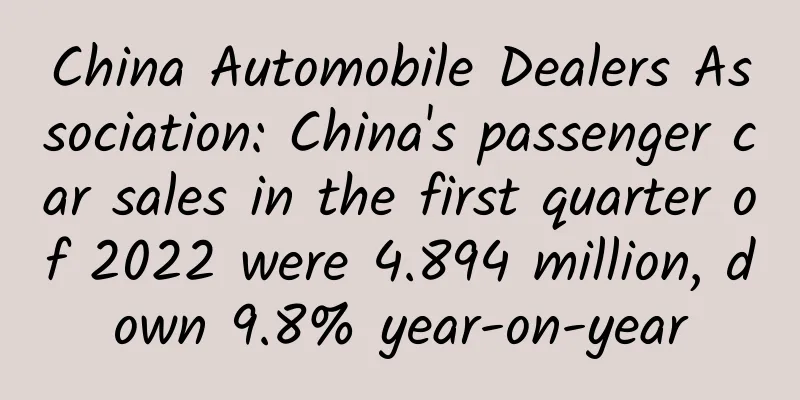China Automobile Dealers Association: China's passenger car sales in the first quarter of 2022 were 4.894 million, down 9.8% year-on-year

|
In the first quarter of 2022 , domestic passenger car sales were 4.894 million units, down 9.8% year-on-year and 14.1% from the fourth quarter of 2021 ; new energy vehicle sales were 1.006 million units, down 11.9 % month-on-month and up 133.0% year-on-year , with a market share of 20.6% ; among them, pure electric new energy vehicle sales were 789,000 units, down 15.0% month-on-month and up 119.4% year-on-year . In the first quarter, sales of luxury cars reached 861,000 units, down 10.2 % year-on-year , up 6.6% from the fourth quarter of 2021, with a market share of 17.6% ; sales of luxury brands and new forces high-end new energy vehicles reached 199,000 units, down 7.0% month-on-month and up 64.7% year-on-year . In the first quarter, sales of domestic luxury cars reached 570,000 units, up 11.8% month-on-month and down 14.4% year-on-year ; sales of imported luxury cars reached 180,000 units, down 18.6% year-on-year. Among imported luxury cars, Lexus ranked first with sales of 46,000 units, Mercedes-Benz sold 43,000 units, and BMW sold 32,000 units. Due to the domestic production of X5 , imports will decline further this year. Affected by the epidemic, some regions and cities were closed, resulting in a decline in sales The auto market had a good start in January 2022, with passenger car sales reaching 2.262 million units , continuing the sales trend in December 2021. After the New Year in February , some areas were affected by the epidemic, and later cities such as Jilin Province began to close down to control the epidemic, resulting in interruptions to the auto supply chain. Coupled with the chip shortage, some automakers began to reduce or even stop production, and this situation continued until mid- April . In the first quarter of 2022 , due to the impact of the epidemic, new car sales in Central China and Northwest China fell by more than 15% year -on-year, in Northeast China by 13.7% , in Southwest China by 12% , and in East China by 8% . In January , Shaanxi and Henan provinces were the most severely affected by the epidemic, with sales falling by 57.4% and 30.2% respectively ; the lockdown in Xi'an caused a 77% year-on-year decline in local sales; Zhengzhou's new car sales fell by 45% due to the epidemic , and Tianjin's new car sales fell by 44% . In March , the lockdown in Jilin Province caused a year-on-year decline in new car sales in the province by 76.8% , and new car sales in Heilongjiang and Liaoning fell by 48.7% and 40.9% respectively ; Shanghai was affected by the epidemic from mid- March , and new car sales fell by 37.9% , and sales will fall more in April. In January , the epidemic mainly affected the northwest, southwest, and central China regions, which only accounted for 33% of domestic new car sales ; in March , the epidemic mainly affected the eastern coastal areas such as Beijing, Tianjin, Hebei, Shandong, Shanghai, and Guangdong, which accounted for more than 60% of domestic new car sales ; the epidemic in March had a relatively large impact on domestic automobile production and consumption. Luxury car market prices and discounts remain stable in March On April 18 , the National Bureau of Statistics released statistics showing that the total retail sales of consumer goods in China in March was 367.3 billion yuan, down 7.5% year-on-year ; the total retail sales of automobiles in the first quarter was 1073.9 billion yuan, down 0.3% year-on-year . In March , the prices and discount levels of the luxury car market did not change much compared with the previous month. The average transaction price of new cars in the luxury car market was 427,000 yuan, up 7,000 yuan from the previous month, mainly due to the increase in sales of high-value models. The average discount level in the market remained at around 11% , the same as the previous month. Mercedes-Benz was less affected by the epidemic in the first quarter, while BMW Brilliance and FAW Audi temporarily stopped production In the first quarter of 2022 , sales of luxury brand cars were 861,000 units, down 10.2% year-on-year and 6% from the fourth quarter of 2021 ; among them, super luxury brands sold 1,998 units, up 2.3% year-on-year . In the first quarter, due to the shortage of chips and the interruption of supply chain caused by the lockdown of some provinces, the production of various automakers was affected to varying degrees. From the end of March to mid-to-late April , automakers such as BMW Brilliance, Tesla, FAW Group, and SAIC Group stopped production to fight the epidemic; data from the China Passenger Car Association showed that BMW Brilliance's production in the first quarter was 108,000 vehicles, a year-on-year decrease of 35% , of which only 31,000 vehicles were produced in March , a year-on-year decrease of 51% ; Beijing Benz did not stop production in the first quarter, with a production of 137,000 vehicles, a year-on-year decrease of 16% , of which 42,000 vehicles were produced in March , a month-on-month decrease of 31% ; FAW Audi's production in the first quarter was 141,000 vehicles, a year-on-year decrease of 14% , of which 28,000 vehicles were produced in March , a month-on-month decrease of 62% ; Cadillac's production in the first quarter was 23,000 vehicles, a year-on-year decrease of 37% ; In addition, among domestic luxury cars, Lincoln's production has been guaranteed with the support of Ford. The sales volume of luxury cars in the first quarter of this year is similar to that in the second half of last year. The main competition among brands is the production of domestically produced cars. Affected by the epidemic, coupled with the shortage of chips and parts, whichever company does not stop production and produces more will ensure sales. In the first quarter, BMW brand sold 197,000 vehicles, up 13.1% from the previous month and down 11.0% from the previous year . MINI brand sold 7,980 vehicles, up 45.2% from the previous month and down 1.1% from the previous year . Mercedes-Benz brand sold 194,000 vehicles, up 15.6% from the previous month and down 11.3% from the previous year, a difference of 2,930 vehicles. Audi brand sold 160,000 vehicles, up 22.0% from the previous month and down 18.7% from the previous year. In the first quarter, the domestic Mercedes-Benz had some improvement in parts supply compared with last year, and was better than BMW and Audi in new car production; the sales gap between Mercedes-Benz and BMW also began to narrow. Among the super luxury brands, Bentley sold 870 vehicles, down 6.7% year-on-year ; Rolls-Royce sold 374 vehicles, down 4.3% year-on-year; Lamborghini sold 285 vehicles, up 30.1 % year-on-year ; Aston Martin sold 213 vehicles, up 11.5% year-on-year ; Ferrari sold 202 vehicles, up 16.1% ; McLaren sold 45 vehicles, up 9.8% year-on-year. Super luxury brands are mostly sold by order, and the sales volume of the month does not reflect the current market demand; due to the impact of the epidemic on the cities with large new car sales in the eastern coastal areas, this has a certain impact on the super luxury brands' new orders. Sales of luxury brands and new forces' high-end new energy vehicles continue to grow In the first quarter, luxury brands and new forces sold nearly 200,000 high-end new energy vehicles , a year-on-year increase of 64.7% , accounting for 20% of new energy vehicles ; among them, pure electric models sold 148,000 units, a year-on-year increase of 53.0% . In addition to Tesla, traditional fuel luxury brands have also accelerated the localization of pure electric new energy models. BMW launched the ix3 in China in 2021 , and subsequently launched the imported pure electric models i4 , ix and the domestic mid-size sedan i3 ; Mercedes-Benz launched the imported EQS , the domestic EQA , EQB , and will also launch the domestic EQE and EQS SUV after the domestic EQC . Second-tier luxury brands have less investment in new energy models. Previously, Cadillac announced the price of the first domestic pure electric medium and large SUV LYRIQ , and Lexus released the pure electric model RZ in April . (Note: Traditional fuel luxury brands refer to Mercedes-Benz, BMW, Audi, Porsche, Lexus, Cadillac, Volvo, Lincoln, Land Rover, MINI , Jaguar, Infiniti, Acura, Maserati, Rolls-Royce, Bentley, Ferrari, Lamborghini, Aston Martin, and McLaren; luxury brands and new forces high-end new energy vehicles refer to the above brands as well as Tesla, Weilai, and Ideal; new energy vehicles refer to pure electric, plug-in hybrid, and extended-range electric vehicles;) Benz In the first quarter of 2022 , Mercedes-Benz brand new cars sold 194,000 units in China , down 11.3% year -on-year and up 15.6% from the fourth quarter of 2021 ; among them, domestic car sales were 151,000 units, up 15.7% month-on-month and down 15.0% year-on-year ; imported car sales were 43,000 units, up 15.2% month-on-month and up 4.0% year-on-year . Mercedes-Benz was affected by the chip shortage in the second half of 2021, and its production capacity was lower than market demand. After February , Beijing Benz's production situation was better than that of BMW Brilliance and FAW Audi, especially in March , when FAW stopped production due to the closure of Jilin City, and an epidemic also occurred in Shenyang, BMW Brilliance stopped production, but Mercedes-Benz's factory in Beijing did not stop production; data from the China Passenger Car Association in April showed that Beijing Benz produced 42,000 vehicles, while FAW Audi produced 28,000 vehicles and BMW Brilliance produced 31,000 vehicles during the same period, which provided favorable support for Mercedes-Benz's wholesale sales. In terms of sales, the reduction in competing new car resources is conducive to the recovery of retail prices and the increase of sales profits; Mercedes-Benz imported cars achieved positive growth both month-on-month and year-on-year, which is conducive to increasing dealers' revenue and profits. In March , Mercedes-Benz brand new car sales were 61,000 units, up 52.5% month-on-month and down 20.0% year-on-year ; among them, domestic car sales were 47,000 units, up 48.8 % month-on-month and down 22.9% year-on-year ; imported car sales were 14,000 units, up 66.1% month-on-month and down 7.9% year-on-year . In March , the average transaction price of Mercedes-Benz brand was around 480,000 yuan, with a brand discount of around 8% , and the average transaction price rose slightly compared with the previous month. BMW In the first quarter, BMW brand new car sales in China were 197,000 units, down 11.0% year-on-year and up 13% from the fourth quarter of 2021 ; among them, domestic car sales were 165,000 units, up 20.0% month-on-month and down 6.3% year-on-year ; among domestic cars, BMW 3 Series sales were 42,000 units, down 11.8% year-on-year ; 5 Series sales were 40,000 units, up 2.4 % year-on-year ; X3 sales were 33,000 units, down 3% year-on-year . In the first quarter, BMW imported car sales were 32,000 units, down 29.4% year-on-year . With the domestic production of BMW X5 , the total number of BMW imported cars this year will decrease. In the first quarter, MINI brand new car sales were 7,980 units, down 1.1% year-on-year . In March , BMW brand new car sales were 50,000 units, up 28.0% month-on-month and down 35.8% year-on-year ; among them, domestic car sales were 41,000 units, up 26.0% month-on-month and down 34.9% year-on-year ; imported car sales were 8,600 units, up 38.3% month-on-month and down 40.0% year-on-year . In March , the average transaction price of BMW brand was around 410,000 yuan, with a brand discount of nearly 10% , and the average transaction price was slightly lower than the previous month. In March , MINI brand new car sales were 2,670 units, down 10.6% year-on-year . Audi In the first quarter, Audi brand new car sales in China were 160,000 units, down 18.7% year-on-year and up 22% from the fourth quarter of 2021 ; among them, domestic car sales were 147,000 units, up 26.4% month-on-month and down 16.9% year-on-year ; imported car sales in the first quarter were 13,000 units, down 34.5% year-on-year . In March , Audi brand new car sales were 48,000 units, up 21.8% month-on-month and down 33.3% year-on -year ; among them, domestic car sales were 43,000 units, up 19.9% month-on-month and down 32.8% year-on-year ; imported car sales were 4,520 units, up 43.9% month-on-month and down 37.4% year-on-year . In March , the average transaction price of Audi brand was around 330,000 yuan, with a brand discount of nearly 16% , and the average transaction price dropped by nearly 10,000 yuan compared with the previous month. Lexus ◢ In the first quarter, Lexus brand sold 46,000 vehicles, down 23.5% year-on-year and up 21% from the fourth quarter of 2021 ; among them, Lexus ES sold 16,000 vehicles, up 50% month-on-month , ES HEV sold nearly 10,000 vehicles, down 16.3% year-on-year ; RX sold 10,000 vehicles, and RS HEV sold 1,905 vehicles. In March , Lexus sold 17,000 vehicles, down 31.9% year-on-year . The average transaction price of Lexus new cars in March was 450,000 yuan. Cadillac ◢ In the first quarter, Cadillac brand sold 43,000 vehicles, down 26.9% year-on-year ; in March , Cadillac brand sold 12,000 vehicles, down 40.7% year-on-year . The average transaction price of Cadillac new cars in March was 289,000 yuan, with a discount of about 18% . Volvo In the first quarter, Volvo brand sold 36,000 vehicles, down 17.3% year-on-year ; in March , Volvo brand sold 13,000 vehicles, down 18.2% year-on-year ; in March , the average transaction price of Volvo new cars was 350,000 yuan, a discount of about 21% . Jaguar Land Rover In the first quarter, Land Rover brand sold 17,000 vehicles, down 18.7% year-on-year ; in March , Land Rover brand sold 5,450 vehicles, down 25.5% year-on-year ; in the first quarter, Jaguar brand sold 3,768 vehicles, down 46.5% year-on-year ; in March , Jaguar brand sold 1,630 vehicles, down 30.4% year-on-year ; in March , the average transaction price of Land Rover new cars was 750,000 yuan, a discount of about 15% , and the average transaction price of Jaguar new cars was 310,000 yuan, a discount of about 25% . Porsche In the first quarter, Porsche brand sold 18,000 vehicles, down 12.7% year-on-year ; in March , Porsche brand sold 7,170 vehicles, down 14.1% year-on-year ; in March , the average transaction price of Porsche new cars was 940,000 yuan. Lincoln In the first quarter, Lincoln brand sold 19,000 vehicles, down 0.6% year-on-year ; in March , Lincoln brand sold 6,340 vehicles, down 13.9% year-on-year ; in March , the average transaction price of Lincoln new cars was 370,000 yuan. Sales data of other brands: |
<<: 55-inch 4K TV sells for 7999! Is Coocaa T55 a risky move?
>>: HTC: It will take three to five years for virtual reality to become mainstream
Recommend
I don't have to worry about breast cancer because no one in my family has had it? Is breast cancer a terminal illness? The truth is...
With the improvement of living standards and heal...
COCOPICO N1 portable cinema experience: playing projection like a mobile phone is no longer a dream
Perhaps it is the inflated housing prices that ha...
"91 Ten Articles" - A daily must-read briefing for the new energy vehicle industry (210224)
1. Toyota's future smart city themed experime...
How to follow the hot topics in the three major sections of content, community and event operation?
Today I will mainly share my experience and opera...
What is the "lung adenocarcinoma" that the famous magician suffers from? Here is the prevention manual →
Recently, the famous magician Liu Qian was interv...
How to distinguish "double positive" from influenza A? Can they be infected at the same time? Experts explain →
At the press conference of the Joint Prevention a...
Google's Pilex phone blocks users from calling 911
At the end of November, Reddit user KitchenPictur...
iPhones shut down due to freezing? Apple responds: It's too cold
This cold wave was so severe that it affected eve...
How to name a brand, here are 6 tips!
Written at the beginning: The success of big bran...
What kind of magic is used to turn "silicon" into "solar cell"?
Produced by: Science Popularization China Produce...
How to choose the most effective promotion channel for APP?
After the APP is launched, promoting the product ...
International Olympic Day | Strange knowledge has been added! Can you believe it? These were once Olympic events!
According to data from the World Health Organizat...
What do alien life forms look like, and what is the ultimate evolutionary goal of intelligent life forms?
Many netizens have asked about this question. It ...
Fasting = stimulating cell autophagy, can it improve Alzheimer's disease?
Recently, Rong seems to like talking about food. ...
After several offline sharing sessions, this is the methodology I summarized about corporate communities.
One of them recently traveled to several province...







![[Girls' Emotions] Love psychology to save singles, find a good man to love you](/upload/images/67cc26ab00c4f.webp)

